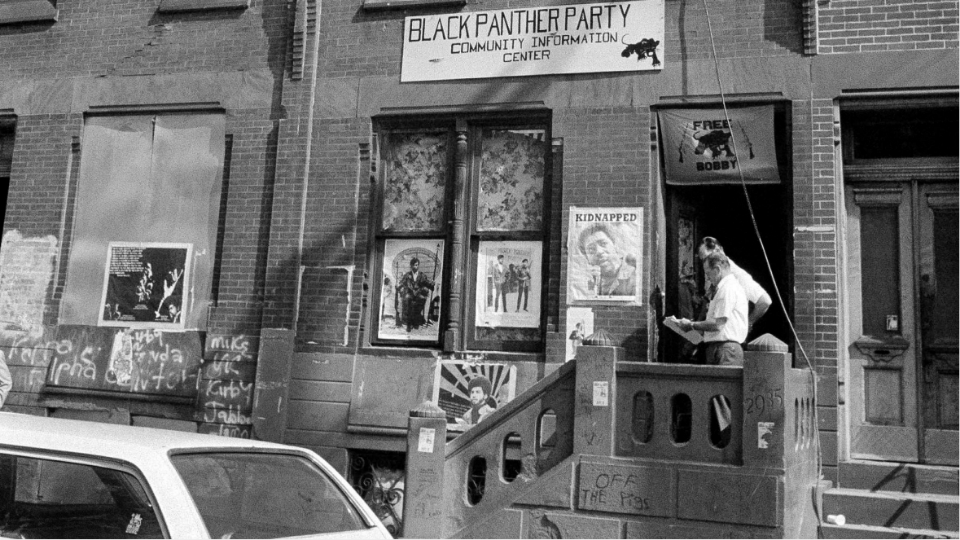[ad_1]

The Black Panther Celebration’s Los Angeles headquarters, because it regarded in 1970. | AP
LOS ANGELES — In one of many a number of publications I learn, I just lately noticed an advert from the College of California Press promoting its Folks’s Information collection. The 5 titles within the collection embody Los Angeles, New York Metropolis, San Francisco Bay Space, Higher Boston, and Orange County (Calif.).
I questioned how a lot of the L.A. story I already knew, and what number of gaps remained in my information. I discovered: Much more gaps.
Which fits to show: A very good information e-book is just not just for vacationers however for residents as effectively. As a result of I had simply seen the advert, I assumed these have been latest books. When my assessment copy of A Folks’s Information to Los Angeles arrived, I observed that its publication date was 2012, so it’s a decade previous already. Which might be a very long time. Locations change, previous telephone numbers may not work, hours of enterprise is probably not present, and native eateries within the neighborhood of highlighted areas could not exist. Verifying present info is suggested.
Journey guides have character. A Fodor’s Information to Europe (on $5 a Day after I first began exploring the world!) goes to be fairly completely different from a Michelin Information with its well-known restaurant rankings, or from a Lonely Planet e-book geared toward youthful, hipper, extra vigorous vacationers. They enchantment to completely different clienteles, by revenue, training and different elements. An previous pal of mine in New York Metropolis had some success a few years again with a public toilet information referred to as The place To Go.
The very phrase “tourism” summons up a category of individuals with disposable revenue, time to get away unencumbered, and solely a superficial curiosity within the locations they go to (museums, amusement parks, landmark church buildings, picturesque bohemian quarters). Many could return dwelling with clearer impressions (and photographs) of some memorable meals than anything, and will by no means as soon as have had something however a passing alternate of dialog with a neighborhood, a resort clerk, a taxi driver, a tour information. These are just a few methods strangers can expertise a spot.
Different information books, says the UC Press, “don’t mirror the fact of life for many city residents—together with individuals of coloration, the working class and poor, immigrants, indigenous individuals, and LGBTQ communities—nor are they embedded inside a scientific evaluation of energy, privilege, and exploitation. We’d like a unique type of guidebook: one which explains energy relations in a means everybody can perceive, and which shares tales of battle and resistance that encourage and educate activists, college students, and significant thinkers.”
As such, the Folks’s Information collection takes a reader right into a deeper appreciation of why sure neighborhoods are the way in which they’re, why freeways have been constructed the place they have been, why the inhabitants of this or that district is so overwhelmingly African-American or Latino, and so forth. It’s as if as soon as he had accomplished writing A Folks’s Historical past of america, Howard Zinn then turned to guidebooks that will present how and the place that historical past advanced.
The L.A. information is split into six regional sections and a seventh chapter with steered routes overlaying particular pursuits vacationers would possibly want to give attention to: First Peoples, Radical Folks-of-Coloration Actions of the Nineteen Sixties and ’70s, Queer Politics and Tradition, Unbiased and Various Media, Financial Restructuring and Globalization, New Organizing, and Environmental Justice. These itineraries contain at the very least a day-long dedication with a lot driving throughout a big city metropolis.
The regional chapters embody North Los Angeles, The Higher Eastside and San Gabriel Valley, South Los Angeles, The Harbor and South Bay, The Westside, and The San Fernando Valley and North Los Angeles County. Anybody who lives in L.A. or its environs, and certainly anybody who’s visited, is aware of that every of those chapters in and of itself encompasses an enormous territory.
It took me some time to know the organizing precept of the e-book and its contents. One would possibly presume that the 20-odd web site listings for every chapter would lead a customer conveniently from one to the subsequent. I used to be incessantly struck by how distant one web site was from the subsequent and the subsequent. Till I spotted that inside every chapter the websites are organized not in logical geographical procession however in alphabetical order! Since one wonderful characteristic of the information is its index, locale listings from A to Z didn’t make a lot sense to me. If from afar you’re solely studying the textual content for its content material and also you’re not truly on the bottom utilizing it for reference, I assume this doesn’t current an issue. However an precise customer to L.A. with the information in hand would discover this unhelpful. In case you do plan to make use of this information in situ, I’ve this suggestion: Learn the chapter, pick the websites you wish to see, mark them in pink on the clear, helpful map supplied as every chapter’s frontispiece and plot out your route.
Some websites are mentioned in additional generic phrases, corresponding to neighborhoods the place intense struggles over integration befell, symbolized by a single dwelling the place the primary (Latino) (Black) (Japanese) household moved in. The home itself is just not a lot to see, however that is the character of “individuals’s historical past” instructed “from the underside up.” We’re L.A. to not elevate the curtain on the wealthy and well-known of Beverly Hills—take the Hollywood Superstar Tour for that—however to achieve perception into mass actions of the poor and dealing individuals, whose achievements are usually not recorded in private kind however within the combination.
For instance, would possibly you wish to pay homage to the historic Black Panther Celebration headquarters at 4115 S. Central Ave. in South L.A. that was stormed by tons of of LAPD officers one early morning in December 1969? Effectively, they demolished the constructing, and the Southern California chapter finally closed down. “The previous web site,” the Information tells us, “photographed in 2007, is now a parking zone flanked by a Mexican market and small companies” (as of 2012). A few of this historical past actually is healthier studying than seeing.
The e-book is a useful 6 by 9 inches on shiny paper, with clear, distinct illustrations, 91 in coloration and 67 black and white, with six line illustrations and 14 maps. And it’s effectively written, I have to say. Maybe it’s the style of journey writing itself that brings out the lyrical impulse in writers, however that is the type of wordsmithing worthy of an Emile Zola, a Jack London, a Mike Gold or George Orwell. I discovered myself underlining not solely sure locales of curiosity however the proletarian philosophy expressed in lots of passages:
“The battle over who and what belongs in suburbia, and who and what doesn’t, is vibrant and ongoing, the racial and financial issues and continued want for status and exclusivity are sometimes submerged in debates in regards to the high quality of faculties, tax charges, and crime and security.”
Though a lot of the knowledge supplied within the Information wouldn’t essentially lead me to go to the positioning in query, I did be taught numerous attention-grabbing info. As an example, “The satirically named California Act for the Authorities and Safety of Indians of 1850 allowed any white individual to put up bail for convicted Indians whom he may then require to repay the superb by working for him—a brand new type of slave labor.” That Griffith Park is “the biggest city park in america.” That the “Wat Thai (Thai Temple) of Los Angeles is the biggest Thai Buddhist temple within the nation.” That World Conflict II enhancements “reworked LAX into the nation’s first airport designed for the jet age.” And that (at the very least as of 2012), the response to the April 29, 1992, acquittal within the Rodney King police beating case “led to the biggest city unrest in U.S. historical past.” Or that “one-third of the Japanese labor drive [in the 1930s] consisted of gardeners”—as unbiased staff “with comparatively little capital,” they may earn a number of occasions what a manufacturing facility or agricultural employee may make.
And the Information affords a unique, vital perspective {that a} extra industrial Baedeker may not. For instance, “California’s native vegetation are ideally suited to their local weather and want minimal irrigation and upkeep. For the reason that starting of Spanish incursions within the 1500s, nevertheless, California’s native species and plant communities have been below assault by invader species. Particularly pernicious are the nonnative grasses (corresponding to inexperienced lawns) and different vegetation with which Southern Californians search to copy japanese U.S. and European landscaping.”
Summing up a historic 1933 garment staff’ strike, the authors use their tutorial coaching and populist politics to jot down this little gem of clear, expository prose:
“The ultimate settlement didn’t end in main financial advantages for the employees, however the strike was nonetheless extraordinarily important by way of regional labor, gender, and racial politics. First, it laid the groundwork for the formation of the Worldwide Girls’ Garment Employees Union in Los Angeles. Second, the strike was one of many first cases when ethnic Mexican staff bargained below American unions moderately than by way of unbiased unions or employee associations. Third, it supplied Mexicanas in Los Angeles with their first style of what it was prefer to take part in organized labor. Fourth, it proved to the world that Mexican girls may and would arrange (which many individuals had doubted), difficult stereotypes of Mexicanas as docile, nonconfrontational, and simply exploitable staff.”
The three authors, with their 2012 biographical knowledge, embody Laura Barraclough, Assistant Professor of American Research, Yale College, writer of Making the San Fernando Valley: Rural Landscapes, City Growth, and White Privilege; Wendy Cheng, Assistant Professor of Asian Pacific American Research and Justice & Social Inquiry, Arizona State College, award-winning photographer and writer of The Changs Subsequent Door to the Díazes: Remapping Race in Suburban California; and Laura Pulido, Professor of American Research and Ethnicity, USC, writer of Black, Brown, Yellow, and Left: Radical Activism in Los Angeles and Environmentalism and Financial Justice: Two Chicano Struggles within the Southwest.
Documenting 115 little-celebrated websites in Higher L.A. the place struggles associated to race, class, gender, and sexuality have occurred, A Folks’s Information to Los Angeles features a wealth of bibliographical cross-references and aids. Although it has its formal limitations as both a guidebook per se or a normal historical past of the town and county, it interrogates vital energy relationships as the town and economic system take form over the centuries, and the way this historical past stays embedded and largely nonetheless seen within the ever-shifting panorama. In case you stay in L.A. or love the town, it’s value a spot in your library.
A Folks’s Information to Los Angeles
by Laura Pulido, Laura R. Barraclough, Wendy Cheng
College of California Press, 2012
328 pp.
ISBN: 9780520270817
[ad_2]
Source link



Recent Comments